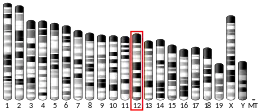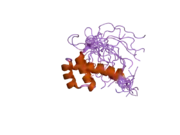Goosecoid protein
Homeobox protein goosecoid is a protein that in humans is encoded by the GSC gene.[5][6] This gene encodes a member of the bicoid subfamily of the paired (PRD) homeobox family of proteins. The encoded protein acts as a transcription factor and may be autoregulatory. A similar protein in mice plays a role in craniofacial and rib cage development during embryogenesis.[6]
Koller's sickle is the first to express the chick homeobox gene goosecoid (GSC).[7]
Function
The GSC gene defines neural-crest cell-fate specification and contributes to dorsal - ventral patterning. Over activation in Xenopus promotes dorso-anterior migration and dorsalization of mesodermal tissue of the cells along with BMP-4.[8] Conversely, loss-of-functions analysis indirectly prevented head formation in Xenopus [9] and head defects in zebrafish.[10] Although, knock-out studies in mice showed that the GSC gene is not required for gastrulation but there is still reduction of the base of the cranium. A mutation in the GSC gene in Drosophila is lethal.[11]
Gsc gene promotes the formation of Spemann’s Organizer. This organizer prevents BMP-4 from inducing the ectoderm in the future head region of the embryo to become epidermis; it instead allows the future head region to form neural folds, which will eventually turn into the brain and spinal cord. For normal anterior development to occur, Spemann’s organizer cannot express the Xwnt-8 or BMP-4 transcription factors. Gsc directly represses the expression of Xwnt-8 while indirectly repressing BMP-4.[12] The inhibition of Xwnt-8 and BMP-4 ensures that normal anterior development, promoted by Spemann’s organizer, can occur.
The expression of Gsc occurs twice in development, first during gastrulation and second during organogenesis.[13] Gsc is found in high concentrations in the dorsal mesoderm and endoderm during gastrulation. The later expression of Gsc is confined to the head region. In the Xenopus, cells that express Gsc become the pharyngeal endoderm, the head mesoderm, ventral skeletal tissue of the head, and the notocord.[14]
Mutations
A mutation in the GSC gene causes short stature, auditory canal atresia, mandibular hypoplasia, and skeletal abnormalities (SAMS). SAMS was previously thought to be an autosomal-recessive disorder but studies with molecular karyotyping and whole-exome sequencing (WES) has shown otherwise.[15]
Mutations in the Gsc gene can lead to specific phenotypes resulting from the second expression of the Gsc gene during organogenesis. Mice knock-out models of the gene express defects in the tongue, nasal cavity, nasal pits, inner ear, and external auditory meatus.[16] Neonate mice born with this mutation die within 24 hours due to complication with breathing and sucking milk, resulting from the craniofacial abnormalities caused by the mutation. Mutations to the Gsc gene in humans can lead to a condition known as SAMS syndrome, characterized by short stature, auditory canal atresia, mandibular hypoplasia, and skeletal abnormalities.[15][17]
Role in cancer development
Due to its role as a transcription factor in cell migration during embryonic development, GSC has been looked into as a potential role-player in cancer development and metastasis, since embryonic development and cancer development share similar characteristics. GSC, along with other transcription factors like Twist, FOXC2, and Snail, induce epithelial to mesenchymal transitions by regulating the cell adhesion proteins E-cadherin, α-catenin and γ-catenin expression in epithelial cells.[18] Studies have shown that in highly metastatic ovarian, lung, breast, and other cancer cells, GSC is highly expressed early in the progression of the tumor.[19] Furthermore, high levels of GSC expression in cancer cells correlates with poor survival rates and thus can be used as a prognostic tool.[20] High expression of GSC also correlates with the chemoresistance of the cancer. Therefore, GSC “primes cells for the expression of aggressive phenotypes[19]” and “may be the most potential biomarker of drug response and poor prognosis.[20]”
References
- GRCh38: Ensembl release 89: ENSG00000133937 - Ensembl, May 2017
- GRCm38: Ensembl release 89: ENSMUSG00000021095 - Ensembl, May 2017
- "Human PubMed Reference:". National Center for Biotechnology Information, U.S. National Library of Medicine.
- "Mouse PubMed Reference:". National Center for Biotechnology Information, U.S. National Library of Medicine.
- Blum M, De Robertis EM, Kojis T, Heinzmann C, Klisak I, Geissert D, Sparkes RS (May 1994). "Molecular cloning of the human homeobox gene goosecoid (GSC) and mapping of the gene to human chromosome 14q32.1". Genomics. 21 (2): 388–93. doi:10.1006/geno.1994.1281. PMID 7916327.
- "Entrez Gene: GSC goosecoid".
- Izpisúa-Belmonte JC, De Robertis EM, Storey KG, Stern CD (August 1993). "The homeobox gene goosecoid and the origin of organizer cells in the early chick blastoderm". Cell. 74 (4): 645–59. doi:10.1016/0092-8674(93)90512-o. PMID 7916659.
- Niehrs C, Keller R, Cho KW, De Robertis EM (1993). "The homeobox gene goosecoid controls cell migration in Xenopus embryos". Cell. 72 (4): 491–503. doi:10.1016/0092-8674(93)90069-3. PMID 8095000.
- Steinbeisser H, Fainsod A, Niehrs C, Sasai Y, De Robertis EM (November 1995). "The role of gsc and BMP-4 in dorsal-ventral patterning of the marginal zone in Xenopus: a loss-of-function study using antisense RNA". The EMBO Journal. 14 (21): 5230–43. doi:10.1002/j.1460-2075.1995.tb00208.x. PMC 394633. PMID 7489713.
- Rivera-Pérez JA, Mallo M, Gendron-Maguire M, Gridley T, Behringer RR (September 1995). "Goosecoid is not an essential component of the mouse gastrula organizer but is required for craniofacial and rib development". Development. 121 (9): 3005–12. PMID 7555726.
- Goriely A, Stella M, Coffinier C, Kessler D, Mailhos C, Dessain S, Desplan C (May 1996). "A functional homologue of goosecoid in Drosophila". Development. 122 (5): 1641–50. PMID 8625850.
- Yao J, Kessler DS (August 2001). "Goosecoid promotes head organizer activity by direct repression of Xwnt8 in Spemann's organizer". Development. 128 (15): 2975–87. PMID 11532920.
- Yamada G, Mansouri A, Torres M, Stuart ET, Blum M, Schultz M, De Robertis EM, Gruss P (September 1995). "Targeted mutation of the murine goosecoid gene results in craniofacial defects and neonatal death". Development. 121 (9): 2917–22. PMID 7555718.
- De Robertis E, Blum M, Niehrs C, Steinbeisser H (April 1992). "Mesoderm induction and origins of the embryonic axis: goosecoid and the organizer". Development. 116: 167–171.
- Parry DA, Logan CV, Stegmann AP, Abdelhamed ZA, Calder A, Khan S, Bonthron DT, Clowes V, Sheridan E, Ghali N, Chudley AE, Dobbie A, Stumpel CT, Johnson CA (December 2013). "SAMS, a Syndrome of Short Stature, Auditory-Canal Atresia, Mandibular Hypoplasia, and Skeletal Abnormalities Is a Unique Neurocristopathy Caused by Mutations in Goosecoid". American Journal of Human Genetics. 93 (6): 1135–42. doi:10.1016/j.ajhg.2013.10.027. PMC 3853132. PMID 24290375.
- Yamada G, Ueno K, Nakamura S, Hanamure Y, Yasui K, Uemura M, Eizuru Y, Mansouri A, Blum M, Sugimura K (April 1997). "Nasal and pharyngeal abnormalities caused by the mouse goosecoid gene mutation". Biochemical and Biophysical Research Communications. 233 (1): 161–5. doi:10.1006/bbrc.1997.6315. PMID 9144415.
- Lemire EG, Hildes-Ripstein GE, Reed MH, Chudley AE (January 1998). "SAMS: provisionally unique multiple congenital anomalies syndrome consisting of short stature, auditory canal atresia, mandibular hypoplasia, and skeletal abnormalities". American Journal of Medical Genetics. 75 (3): 256–60. doi:10.1002/(sici)1096-8628(19980123)75:3<256::aid-ajmg5>3.0.co;2-o. PMID 9475592.
- Mani SA, Yang J, Brooks M, Schwaninger G, Zhou A, Miura N, Kutok JL, Hartwell K, Richardson AL, Weinberg RA (June 2007). "Mesenchyme Forkhead 1 (FOXC2) plays a key role in metastasis and is associated with aggressive basal-like breast cancers". Proceedings of the National Academy of Sciences of the United States of America. 104 (24): 10069–74. doi:10.1073/pnas.0703900104. PMC 1891217. PMID 17537911.
- Hartwell KA, Muir B, Reinhardt F, Carpenter AE, Sgroi DC, Weinberg RA (December 2006). "The Spemann organizer gene, Goosecoid, promotes tumor metastasis". Proceedings of the National Academy of Sciences of the United States of America. 103 (50): 18969–74. doi:10.1073/pnas.0608636103. PMC 1748161. PMID 17142318.
- Kang KW, Lee MJ, Song JA, Jeong JY, Kim YK, Lee C, Kim TH, Kwak KB, Kim OJ, An HJ (July 2014). "Overexpression of goosecoid homeobox is associated with chemoresistance and poor prognosis in ovarian carcinoma". Oncology Reports. 32 (1): 189–98. doi:10.3892/or.2014.3203. PMID 24858567.
Further reading
- Schlade-Bartusiak K, Macintyre G, Zunich J, Cox DW (January 2008). "A child with deletion (14)(q24.3q32.13) and auditory neuropathy". American Journal of Medical Genetics Part A. 146A (1): 117–23. doi:10.1002/ajmg.a.32064. PMID 18074379.
- Hartwell KA, Muir B, Reinhardt F, Carpenter AE, Sgroi DC, Weinberg RA (December 2006). "The Spemann organizer gene, Goosecoid, promotes tumor metastasis". Proceedings of the National Academy of Sciences of the United States of America. 103 (50): 18969–74. doi:10.1073/pnas.0608636103. PMC 1748161. PMID 17142318.
- Barrios-Rodiles M, Brown KR, Ozdamar B, Bose R, Liu Z, Donovan RS, Shinjo F, Liu Y, Dembowy J, Taylor IW, Luga V, Przulj N, Robinson M, Suzuki H, Hayashizaki Y, Jurisica I, Wrana JL (March 2005). "High-throughput mapping of a dynamic signaling network in mammalian cells". Science. 307 (5715): 1621–5. doi:10.1126/science.1105776. PMID 15761153.
- Namciu SJ, Friedman RD, Marsden MD, Sarausad LM, Jasoni CL, Fournier RE (March 2004). "Sequence organization and matrix attachment regions of the human serine protease inhibitor gene cluster at 14q32.1". Mammalian Genome. 15 (3): 162–78. doi:10.1007/s00335-003-2311-y. PMID 15014966.
- Foucher I, Montesinos ML, Volovitch M, Prochiantz A, Trembleau A (May 2003). "Joint regulation of the MAP1B promoter by HNF3beta/Foxa2 and Engrailed is the result of a highly conserved mechanism for direct interaction of homeoproteins and Fox transcription factors". Development. 130 (9): 1867–76. doi:10.1242/dev.00414. PMID 12642491.
- Danilov V, Blum M, Schweickert A, Campione M, Steinbeisser H (January 1998). "Negative autoregulation of the organizer-specific homeobox gene goosecoid". The Journal of Biological Chemistry. 273 (1): 627–35. doi:10.1074/jbc.273.1.627. PMID 9417125.






